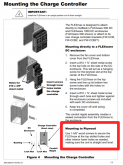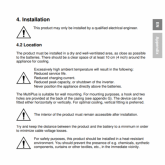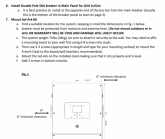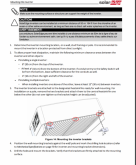I would consider building something like this https://www.mobile-solarpower.com/2000-watt-24v-solar-system.html I would change out a few components, and build my own 24 volt lithium battery. I would get 300+ watt solar panels. Something this size would generally be able to run hair dryer, make coffee , run microwave oven, run many different electrical hand tools. etc. (Not all at the sametime) You may find that this could meet your current and future energy needs. I would spend sometime going over all components, electrical loads, etc. The more time You think of what You want from your system, what's available, and what will work, the better will be the results.
You are using an out of date browser. It may not display this or other websites correctly.
You should upgrade or use an alternative browser.
You should upgrade or use an alternative browser.
400sq ft cabin with 110 wiring. Novice and in need of help.
- Thread starter happycalhoun
- Start date
D
Deleted member 165
Guest
I get to Albuquerque once in a while. Shoot me a PM when you are about to do hookups if you like, and if I'll be around I'd be glad to help you get it set up. If your first name is Eddie and you live near Central, I bought a sweet van from you a couple years back.
happycalhoun
New Member
- Joined
- Jun 30, 2020
- Messages
- 13
I will do that for sure. No van sells for me hahaha but glad you had a good experience in ABQ. Thanks Schlagger for the solar hospitality.I get to Albuquerque once in a while. Shoot me a PM when you are about to do hookups if you like, and if I'll be around I'd be glad to help you get it set up. If your first name is Eddie and you live near Central, I bought a sweet van from you a couple years back.
MichaelK
Solar Wizard
I clicked on your link in post #21 and immediately spotted this on the first page.
Wooden board to mount the components
This is the first clue that they don't know what they're doing! One of first rules of solar is you DO NOT mount solar electronic components on a flamable surface. Secondly, they recommend low budget, bottom tier products. I strongly recommend that you DO NOT follow their advice.
Can you do it their way? Well sure. Should you do it their way? It depends? Do you change your engine oil on time, or do you let it go thousands of miles over? Do you check your account before writing a big check, or don't worry about it? Do you look both ways before pulling out into an intersection, or just proceed? You can do it the right way, or you can do it the way you feel like, but you'll ultimately pay for the consequences.
Wooden board to mount the components
This is the first clue that they don't know what they're doing! One of first rules of solar is you DO NOT mount solar electronic components on a flamable surface. Secondly, they recommend low budget, bottom tier products. I strongly recommend that you DO NOT follow their advice.
Can you do it their way? Well sure. Should you do it their way? It depends? Do you change your engine oil on time, or do you let it go thousands of miles over? Do you check your account before writing a big check, or don't worry about it? Do you look both ways before pulling out into an intersection, or just proceed? You can do it the right way, or you can do it the way you feel like, but you'll ultimately pay for the consequences.
D
Deleted member 165
Guest
I clicked on your link in post #21 and immediately spotted this on the first page.
Wooden board to mount the components
This is the first clue that they don't know what they're doing! One of first rules of solar is you DO NOT mount solar electronic components on a flamable surface. Secondly, they recommend low budget, bottom tier products. I strongly recommend that you DO NOT follow their advice.
Can you do it their way? Well sure. Should you do it their way? It depends? Do you change your engine oil on time, or do you let it go thousands of miles over? Do you check your account before writing a big check, or don't worry about it? Do you look both ways before pulling out into an intersection, or just proceed? You can do it the right way, or you can do it the way you feel like, but you'll ultimately pay for the consequences.
I'm pretty sure that guy knows what he is doing.
I clicked on your link in post #21 and immediately spotted this on the first page.
Wooden board to mount the components
This is the first clue that they don't know what they're doing! One of first rules of solar is you DO NOT mount solar electronic components on a flamable surface. Secondly, they recommend low budget, bottom tier products. I strongly recommend that you DO NOT follow their advice.
You have a point. Never gave the wooden board a thought (but should have). As far as the components shown, they are less expensive, but not the cheapest. Victron, Outback, Battleborn products are more expensive, but are considered higher quality. It's a DIY forum, so people pretty much build what they like. I think in the near future, one is going to see, All in One, "Solar Generators" that will have the capacity and pricing to be competitive with some of the solar projects that are shown here.
D
Deleted member 165
Guest
For those not paying attention, @MichaelK is stating that @Will Prowse has no idea what he's doing. I substantially disagree.
For those not paying attention, @MichaelK is stating that @Will Prowse has no idea what he's doing. I substantially disagree.
I just figure MichealK has a different opinion of how things should be done. Will's YouTube, Website, and this forum has helped me tremendously in building my small inexpensive systems.
While I highly value Will's work and opinion, I have always questioned many people using wood to mount stuff on. I know both my Xantrex inverter and my Renogy charge controller state not to mount on a flammable surface in their manuals.
I ended up mounting a sheet of diamond plate on my shed wall and mounting the equipment on that... (was a PITA to drill thru though)
I ended up mounting a sheet of diamond plate on my shed wall and mounting the equipment on that... (was a PITA to drill thru though)
Why in the world would people not want to mount to wood? I have a 10kW inverter mounted to wood and it passed inspection. And ABYC code states that surface mounted components can safely be attached to wood. They are designed to be mounted to wood/metal etc.
Look up actual low voltage DC systems on boats. They are always mounted to wood:

What you are not allowed to do is mount batteries on wood. That is a big no no. But surface mount components? You can attach them to wood all day long without issue.
Can someone prove me wrong on this? If it is designed to be surface mount, it can be mounted to wood. The case itself is raised from the surface. There are some inverter/chargers, such as the MPP series, that cannot be mounted on combustible surface because it is not raised. But most don't see a problem with it, and Ian from MPP USA said that it's fine. He said it's in the manual to avoid any form of liability.
Look up actual low voltage DC systems on boats. They are always mounted to wood:

What you are not allowed to do is mount batteries on wood. That is a big no no. But surface mount components? You can attach them to wood all day long without issue.
Can someone prove me wrong on this? If it is designed to be surface mount, it can be mounted to wood. The case itself is raised from the surface. There are some inverter/chargers, such as the MPP series, that cannot be mounted on combustible surface because it is not raised. But most don't see a problem with it, and Ian from MPP USA said that it's fine. He said it's in the manual to avoid any form of liability.
Outback FLEXmax manual states that it can be mounted to wood: 
Giandel doesn't state that you cannot mount to wood:
Victron doesn't state anything about not mounting to wood:
Sol ark says to mount to studs:
UL Solaredge manual says it can be mounted to studs or on a wall:
Also, why would a surface mount component cause combustion when proper sized OCPD and conductor are connecting it to the current source? I have had inverters failed in front of me, and the fuse blew after it let out smoke. I did not overvoltage it either. Can someone show me a video or picture of a surface mount component causing combustion of materials it is attached to? Usually it is designed to fail without overheating the mounting points. Can someone show me proof of this not occurring?

Giandel doesn't state that you cannot mount to wood:

Victron doesn't state anything about not mounting to wood:

Sol ark says to mount to studs:

UL Solaredge manual says it can be mounted to studs or on a wall:

Also, why would a surface mount component cause combustion when proper sized OCPD and conductor are connecting it to the current source? I have had inverters failed in front of me, and the fuse blew after it let out smoke. I did not overvoltage it either. Can someone show me a video or picture of a surface mount component causing combustion of materials it is attached to? Usually it is designed to fail without overheating the mounting points. Can someone show me proof of this not occurring?
Last edited:
Steve_S
Offgrid Cabineer, N.E. Ontario, Canada
Point of interest. Wood has to reach approximately 540 degrees F to combust !
If you have any equipment that reaches those sorts of temps, it is trash ! Get rid of it before it gets rid of you !
Why do NEC & Other Electrical codes allow AC Service panels to be attached to Plywood ?
In areas of damp etc, wood is not suggested for obvious reasons. IN such instances, NEC + Code suggests using Fireboard as a backer, alternately, you can use Mag-O (Magnesium Oxide) board which is water & fireproof and will handle up to 2800 degrees Celsius. (it's also 1/2 the price of cement fireboard.) TERMS: FireBoard also known as Cement Backer Board and others depending on your locality. This is not to be confused with Fire Rated Gypsum Drywall.
If you have any equipment that reaches those sorts of temps, it is trash ! Get rid of it before it gets rid of you !
Why do NEC & Other Electrical codes allow AC Service panels to be attached to Plywood ?
In areas of damp etc, wood is not suggested for obvious reasons. IN such instances, NEC + Code suggests using Fireboard as a backer, alternately, you can use Mag-O (Magnesium Oxide) board which is water & fireproof and will handle up to 2800 degrees Celsius. (it's also 1/2 the price of cement fireboard.) TERMS: FireBoard also known as Cement Backer Board and others depending on your locality. This is not to be confused with Fire Rated Gypsum Drywall.
Well, I'm satisfied with that. And it makes sense some vendors warnings are for liability reasons. In fact, I'm going to eat crow a bit, because I can't find any reference in my Xantrex or Renogy Tracer manuals about combustible surface mounting... It's been several years since I wired up my shed. So I can only assume I got the recommendation to avoid wood from the solar-electric forum:
The best practice is to mount it on a non-combustible surface. Electrical panels and power electronics can get very hot when there is a loose or corroded connection. A non combustible surface is an extra measure of safety. A masonry wall would be best, but on a framed wall I think cement board or sheetrock would be better than plywood or paneling.
I also forgot that I ended up putting a cement board up over the plywood and mounting everything else to that (that was easier that drilling through the diamond plate)
The best practice is to mount it on a non-combustible surface. Electrical panels and power electronics can get very hot when there is a loose or corroded connection. A non combustible surface is an extra measure of safety. A masonry wall would be best, but on a framed wall I think cement board or sheetrock would be better than plywood or paneling.
I also forgot that I ended up putting a cement board up over the plywood and mounting everything else to that (that was easier that drilling through the diamond plate)
Why in the world would people not want to mount to wood? I have a 10kW inverter mounted to wood and it passed inspection. And ABYC code states that surface mounted components can safely be attached to wood. They are designed to be mounted to wood/metal etc.
Thanks Will, for clearing this up.
D
Deleted member 165
Guest
What you are not allowed to do is mount batteries on wood. That is a big no no.
So batteries cannot sit on a wooden shelf?
MichaelK
Solar Wizard
Sulfuric acid dissolves celluloseSo batteries cannot sit on a wooden shelf?
D
Deleted member 165
Guest
Sulfuric acid dissolves cellulose
I'm not talking about leaky lead acid batteries, and I certainly wasn't asking you, as you clearly have lost credibility.
Steve_S
Offgrid Cabineer, N.E. Ontario, Canada
Ohhh My Goodness ! And I went and built Battery Boxes out of 3/4" Plywood ! I MUST BE NUTS, OH ME, OH MY !
LFP has no acid or toxins to harm, injure, maim or kill you. Good thing I tossed the Chicken Little hat away decades ago in favour of critical thinking.
LFP has no acid or toxins to harm, injure, maim or kill you. Good thing I tossed the Chicken Little hat away decades ago in favour of critical thinking.
gnubie
Solar Wizard
- Joined
- Sep 20, 2019
- Messages
- 3,847
If you manage to burn a lifepo4 cell it will release hydrogen fluoride, and when that mixes with water including vapour in the air, or say in your nice wet lungs, you get hydrofluoric acid. You do not want that inside you. A Google search will tell you what will happen. For this reason in Australia you can not install lifepo4 batteries in a 'living area' which essentially means any area of a house that people frequent. The materials around the batteries must not be combustible either. In fact there are pretty tough regulations around lithium cells and batteries in general. We've all seen, and some experienced, just how quickly things go wrong with non-lifepo4 18650 cells.
There are regulations about inverters too. They vary from state to state but you can find that if heat producing items are mounted on wood there must be a flame resistant sheet between the device and the wood. That could be a sheet of cement board. The regulations here move faster than a spinning top so where things stand right now, good question.
Keep in mind that as much as there is a USA tilt to this forum, hardly surprising, there are still a lot of people here from other parts of the world where regulations differ and what you are and aren't allowed to do will vary.
There are regulations about inverters too. They vary from state to state but you can find that if heat producing items are mounted on wood there must be a flame resistant sheet between the device and the wood. That could be a sheet of cement board. The regulations here move faster than a spinning top so where things stand right now, good question.
Keep in mind that as much as there is a USA tilt to this forum, hardly surprising, there are still a lot of people here from other parts of the world where regulations differ and what you are and aren't allowed to do will vary.
Last edited:
MrNatural22
?SW sunshine =⚡️⚡️lit up thru the darkness✌️
Point of interest. Wood has to reach approximately 540 degrees F to combust !
If you have any equipment that reaches those sorts of temps, it is trash ! Get rid of it before it gets rid of you !
Why do NEC & Other Electrical codes allow AC Service panels to be attached to Plywood ?
In areas of damp etc, wood is not suggested for obvious reasons. IN such instances, NEC + Code suggests using Fireboard as a backer, alternately, you can use Mag-O (Magnesium Oxide) board which is water & fireproof and will handle up to 2800 degrees Celsius. (it's also 1/2 the price of cement fireboard.) TERMS: FireBoard also known as Cement Backer Board and others depending on your locality. This is not to be confused with Fire Rated Gypsum Drywall.
It would be a simple solution for anyone concerned to use a piece of 5/8 Sheetrock between the component and your plywood. ?
Ace hardware sells smaller sections of wallboard cheap or
You can find free scrap pieces big enough around most any drywalling job site.
Similar threads
- Replies
- 28
- Views
- 866
- Replies
- 1
- Views
- 368
- Replies
- 5
- Views
- 290


